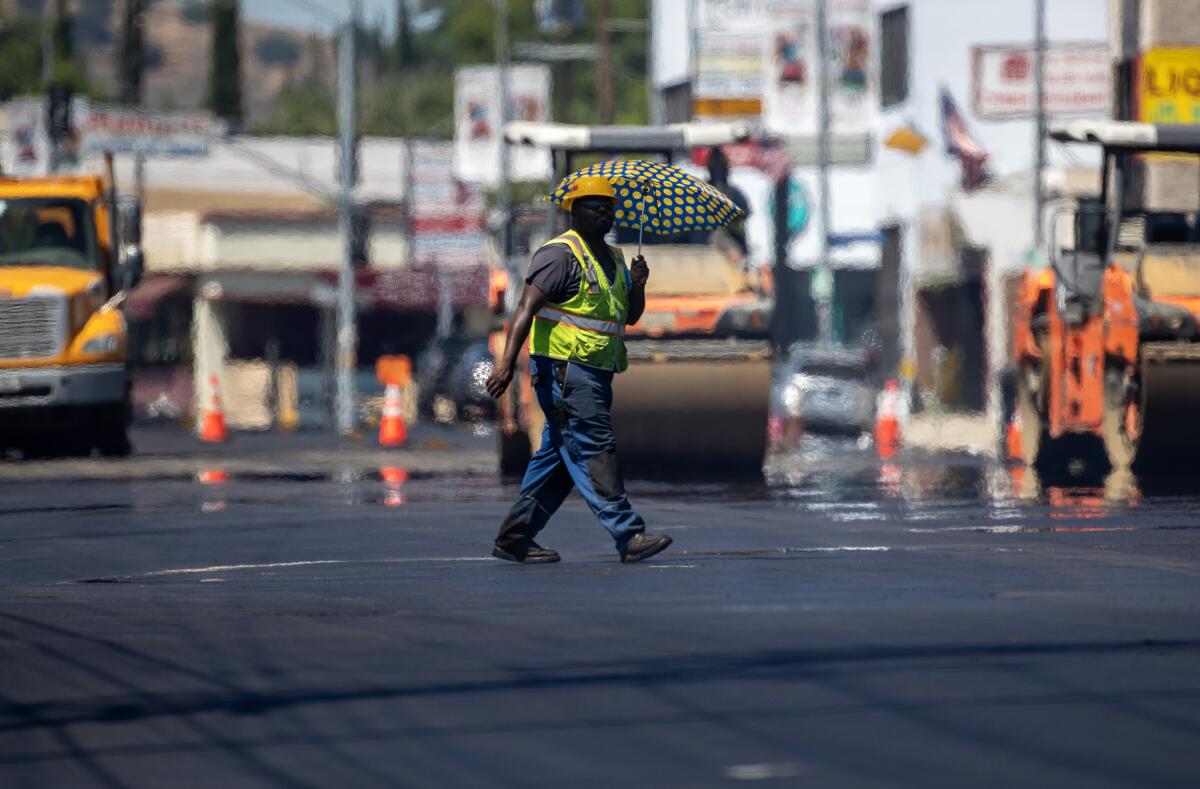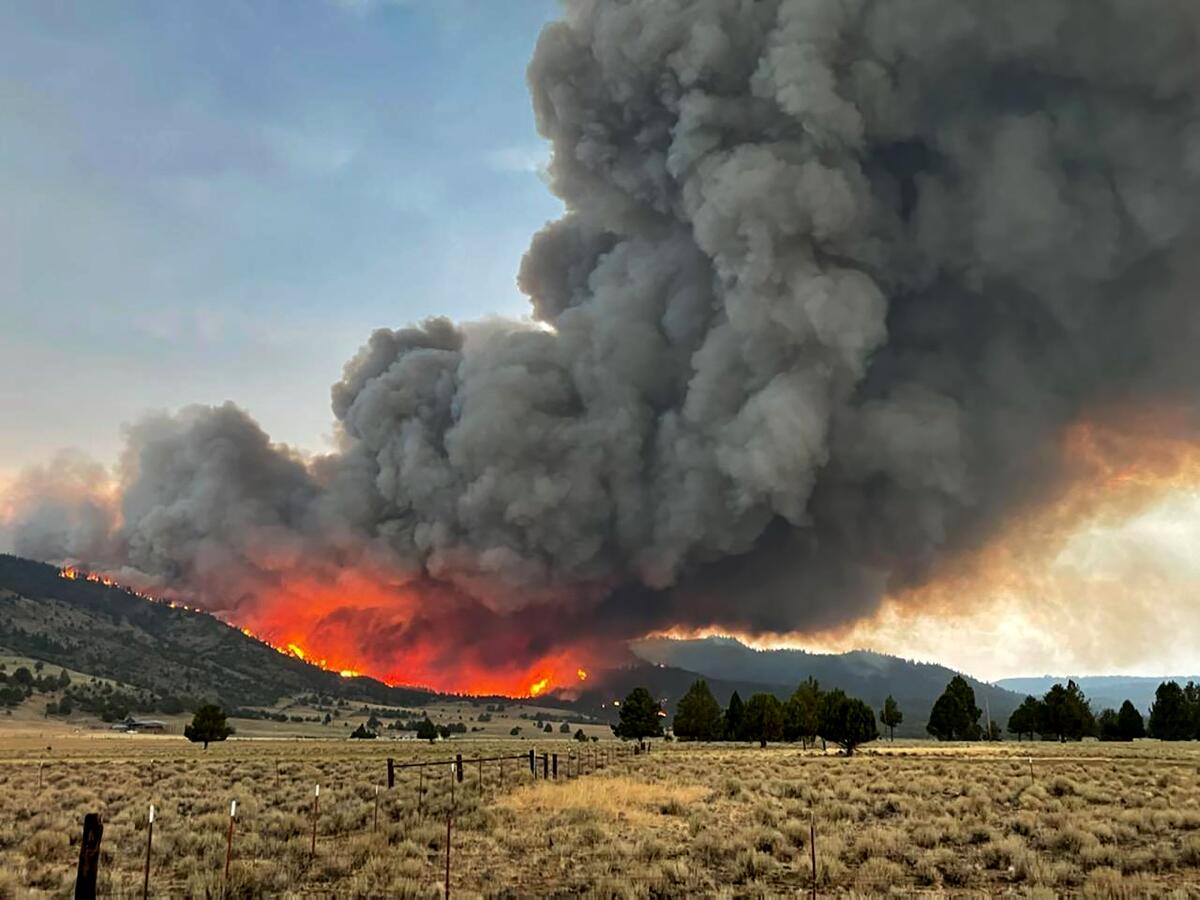Boiling Point: Worried about the heat

- Share via
This story was originally published in Boiling Point, a newsletter about climate change and the environment. Sign up here to get it in your inbox.
Got any questions you’d like to ask an L.A. Times environment reporter?
One week from tonight, my colleague Rosanna Xia and I will be doing a live “Ask a Reporter” event. You can sign up for the virtual discussion here, and share questions when you RVSP. You can also pose questions during the event at 6 p.m. on Sept. 19.
Rosanna covers the California coast and has an amazing book publishing later this month, “California Against the Sea: Visions for Our Vanishing Coastline.” I’ll have a Q&A with Rosanna in Boiling Point next week, too. You won’t want to miss it.
In other news, The Times has launched a new version of our Essential California daily newsletter, written by Ryan Fonseca. Ryan focused on climate change in the first edition of the revamped newsletter, talking with the state’s former insurance commissioner about the rising costs of protecting Californians from wildfires and the turbulent state of the home insurance market.
As always, lots of news this week. Here’s what’s happening around the West:
TOP STORIES

Californians are super concerned about extreme heat, with many saying it has affected them and their families. That’s according to a new poll co-sponsored by The Times, which found that 77% of California voters have recently experienced extreme heat — and 50% lack confidence in the state’s ability to provide reliable power during extended heat waves. Details here from my colleague Hayley Smith, who notes that two-thirds of voters want the state to establish cooling standards for homes that would require air conditioners or other cooling measures. Los Angeles officials are trying to help limit the heat, rolling out 181 miles of “cool pavement” over the last six years, Charlotte Kramon reports — which is great, but we definitely need more, faster.
The Golden State is moving away from emergency requests to use less water during droughts, with state officials instead working to set locally tailored conservation targets that will require big cuts over the next few years, drought or no. What will the target look like where you live? You can find out here what’s been proposed for your water agency, via The Times’ Hayley Smith, Ian James and Sean Greene. In another effort to use water more wisely, there’s a bill moving through the state Legislature — and expected to reach Gov. Gavin Newsom’s desk — clarifying that state officials do, in fact, have legal authority to investigate certain questionable water-rights claims, and stop any illegal water diversions they find. Ian James wrote about the bill.
Leaders of the world’s largest economies are gathered in New Delhi over the weekend for the annual Group of 20 summit, with climate change high on the agenda. Although the participating nations agreed to a tripling of renewable energy, they made no progress on phasing out fossil fuels, Sibi Arasu reports for the Associated Press. My colleagues Courtney Subramanian and Tracy Wilkinson, meanwhile, wrote about the difficult reality that even as Indian Prime Minister Narendra Modi pushes other countries — and his own — to build more clean energy, India remains overwhelmingly reliant on coal. Their story also includes an interesting quote from former Los Angeles Mayor Eric Garcetti, who is now U.S. ambassador to India: “By the end of this decade, Los Angeles will be 97% carbon-free, but I think India’s transition [to clean energy] will be quicker than L.A.,” Garcetti said.
POLITICAL CLIMATE
With two days left until the Sept. 14 deadline for California lawmakers to pass bills this session, it’s coming down to the wire for the high-profile climate proposal on the docket. CNBC’s Catherine Clifford reports that Apple offered a last-minute endorsement for the bill from Sen. Scott Wiener (D-San Francisco), which would require big companies to estimate and disclose planet-warming carbon emissions across their supply chains. In other legislative news, Politico reports that a push by Southern California Gas — and its parent company, Sempra Energy — to secure legislation supporting carbon capture and hydrogen probably isn’t going anywhere this session. Speaking of hydrogen, Politico also reports that Gov. Gavin Newsom’s appointees are pushing the federal government to adopt less-than-green rules for hydrogen tax credits, to the chagrin of many climate advocates.
The Golden State is phasing out electric car rebates for upper-income buyers. Starting soon, all rebates will go to low- and middle-income Californians, Alejandro Lazo reports for CalMatters. It’s the state’s latest effort to target clean energy funding to those who need it most, as falling costs make electric technologies more affordable. In another key area for electrification, 25 California cities — including Los Angeles — have sent a letter to Gov. Gavin Newsom urging him to create a statewide standard requiring new buildings to be all-electric or otherwise zero-emission, LAist’s Erin Stone reports. The request follows a court ruling that rejected the city of Berkeley’s ban on gas in new homes and businesses, jeopardizing dozens of similar local policies.
The Biden administration has canceled the last remaining oil and gas leases in the Arctic National Wildlife Refuge issued by the Trump administration, and announced a plan to protect vast swaths of the state’s National Petroleum Reserve from development. The moves were praised by many conservationists, per Becky Bohrer and Matthew Daly at the Associated Press. But some climate activists were critical, saying the initiatives do little to make up for President Biden’s decision earlier this year to allow the massive Willow oil drilling project in the petroleum reserve, when scientists have called for no new fossil fuel leasing.
AROUND THE WEST

Are environmental rules governing the extraction of crucial minerals on Western public lands too weak, or too strong? The Arizona Republic’s Brandon Loomis poses that question in a fascinating story on the battle over mining for manganese — one of many metals crucial to electric-car batteries and other clean energy technologies, whose extractions can nonetheless be environmentally destructive. In Utah, meanwhile, the Bill Gates-funded startup Lilac Solutions — which has also been active at California’s Salton Sea, as I’ve reported previously — is making a play to extract large amounts of lithium from the Great Salt Lake, with the startup saying it can be done in an environmentally friendly way. Details here from the Salt Lake Tribune’s Leia Larsen.
Burning Man could leave a much bigger scar on Nevada’s Black Rock Desert playa than usual after a torrential rainstorm hit during the festival, stranding tens of thousands of people. “Having all those people out there moving around when it’s wet, that’s a particularly sensitive time in shaping what the playa looks like,” one academic expert told the Nevada Independent’s Amy Alonzo. “When you have people moving around, you’re going to have people eroding the playa in unnatural ways.”
For the first time in decades — if not more than a century — a beaver colony has taken up residence in the Palo Alto area, in the southern San Francisco Bay. That may not sound like a big deal, until you realize that the ecosystem services provided by beavers can help surrounding communities stay safe during droughts, storms and even wildfires, as my colleague Grace Toohey reports. In other wildfire news, the New York Times’ Raymond Zhong has a fabulous story, reported from Montana, about the value that Western fire lookouts stationed in watchtowers still provide in a world of cameras, satellites and artificial intelligence.
THE ENERGY TRANSITION
Southern California Edison has spent 12 years trying to build a 9.3-mile power line to give Riverside — the Inland Empire’s biggest city — a second connection to the regional electric grid. But in yet another example of the difficulty of building badly needed new transmission in the West, critics along the route continue to push for an entirely underground line, despite the high costs, Brooke Staggs reports for the Orange County Register. Critics say an aboveground power line could spark fires, ruin views and harm property values. This is one of many transmission battles playing out across the West, as I’ve reported previously.
“Are consumers getting ripped off? If the answer is yes, we will act.” So says Tai Milder, director of the newly created Division of Petroleum Market Oversight at the California Energy Commission. He was appointed by Gov. Gavin Newsom last month under a new law designed to prevent the oil industry from price-gouging drivers at the gas pump, as Rob Nikolewski reports for the San Diego Union-Tribune. Nikolewski also wrote about California’s state auditor questioning whether Sempra Energy subsidiary San Diego Gas & Electric — which charges some of the nation’s highest electricity rates — is overcharging customers.
Wyoming regulators are gearing up for a wave of applications to pump carbon dioxide underground, in light of new federal tax credits. But the debate over whether this is a viable climate solution rages on, WyoFile’s Dustin Bleizeffer writes.
ONE MORE THING

My colleague Alex Wigglesworth wrote last week about a new study finding that climate change has increased the risk of explosive wildfire growth — where fires add more than 10,000 acres per day — by 25% in California. You can read her story here.
The next day, one of the study’s authors claimed in an opinion piece that he had purposefully left out important details about non-climate factors that fuel dangerous fire conditions, in order to ensure a prominent science journal would publish the study.
“Climate science has become less about understanding the complexities of the world and more about serving as a kind of Cassandra, urgently warning the public about the dangers of climate change. However understandable this instinct may be, it distorts a great deal of climate science research, misinforms the public, and most importantly, makes practical solutions more difficult to achieve,” wrote Patrick Brown, co-director of the climate and energy team at the Breakthrough Institute think tank.
Conservative media had a field day, trumpeting Brown’s claims as the latest sign that climate scientists can’t be trusted.
It sounds bad — until you look under the hood just a little bit.
Robinson Meyer, founding executive editor of Heatmap News, spoke with Brown, and concluded that his actions constitute “one of the most dumbfounding series of events I have ever seen in science.” Peer reviewers at the journal Nature actually pressed Brown to explain why he had left out non-climate drivers of wildfire growth, to which Brown responded that it would have been “very difficult” to study those factors. He told the reviewers he hoped to do more research in this area — which he’s now doing.
And as Meyer notes, journalists including my colleague Alex wrote about the study with nuance, explaining that climate change alone doesn’t determine fire behavior — a reality that undermines Brown’s criticisms of the mainstream media’s climate coverage.
Long story short: There’s not much to see here, except for good journalism. Subscribe to The Times to help us keep doing it.
We’ll be back in your inbox Thursday. To view this newsletter in your Web browser, click here. And for more climate and environment news, follow @Sammy_Roth on Twitter.
Toward a more sustainable California
Get Boiling Point, our newsletter exploring climate change, energy and the environment, and become part of the conversation — and the solution.
You may occasionally receive promotional content from the Los Angeles Times.




